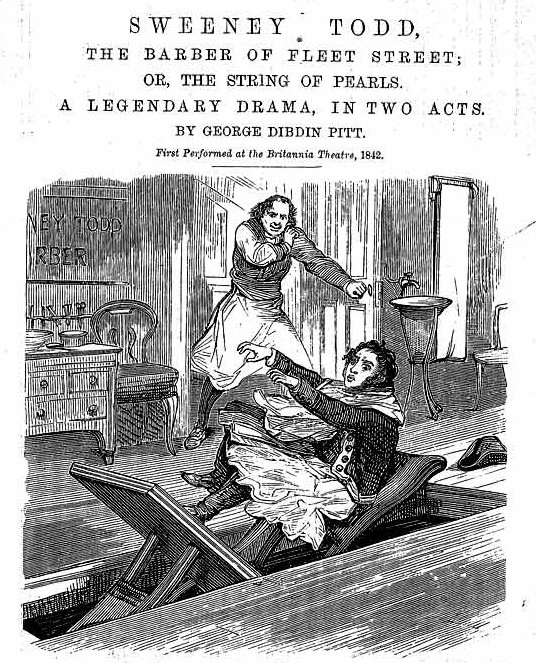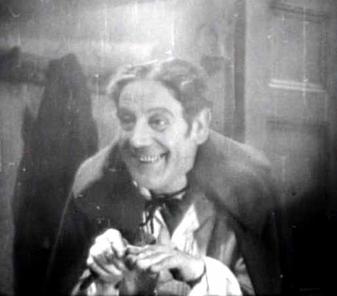
Wikimedia Commons
Sweeney Todd is a fictional character who first appeared as the villain in the Victorian penny dreadfulCheap popular serial literature produced during the 19th century, typically a story published in weekly parts, each costing a penny. serial The String of Pearls (1846–1847). The tale became a staple of Victorian melodrama and has been retold many times since, notably in the Tony award–winning Broadway musical by Stephen Sondheim.
In the original version of the tale, Todd is a barber who dispatches his victims by pulling a lever as they sit in his barber chair. His victims fall backward down a revolving trap door into the basement of his shop, generally causing them to break their necks or skulls. In case they are alive, Todd goes to the basement and “polishes them off” (slitting their throats with his straight razor). In some adaptations, the murdering process is reversed, with Todd slitting his customers’ throats before dispatching them into the basement through the revolving trap door. After Todd has robbed his dead victims of their goods, Mrs. Lovett, his partner in crime (in some later versions, his friend and/or lover), assists him in disposing of the bodies by baking their flesh into meat pies and selling them to the unsuspecting customers of her pie shop. Todd’s barber shop is situated in Fleet Street, London, next to St. Dunstan’s church, and is connected to Mrs. Lovett’s pie shop in nearby Bell Yard by means of an underground passage. In most versions of the story, he and Mrs. Lovett hire an unwitting orphan boy, Tobias Ragg, to serve the pies to customers.
By the 1930s the Sweeney had become established cockney rhyming slang for the Metropolitan Police’s flying squad.[1]
Publication history
The story of Sweeney Todd was published in 18 weekly parts under the title The String of Pearls: A Romance, and appeared in Edward Lloyd’s The People’s Periodical and Family Library, issues 7–24, 21 November 1846 to 20 March 1847.[2] It was probably written by James Malcolm Rymer, although Thomas Peckett Prest has also been credited; it may be that each worked on different parts of the serial. Other attributions include Edward P. Hingston, George Macfarren, and Albert Richard Smith.[3] In February/March 1847, before the serial was completed, George Dibdin Pitt adapted The String of Pearls as a melodrama for the Britannia Theatre in Hoxton. It was in this alternative version of the tale that Todd acquired his catchphrase of “I’ll polish him off”.[4]
Lloyd published another, lengthier, penny part serial from 1847–1848, with 92 episodes. It was then published in book form in 1850 as The String of Pearls, subtitled “The Barber of Fleet Street. A Domestic Romance”. This expanded version of the story was 732 pages long. A plagiarised version appeared in the United States c. 1852–1853 as Sweeney Todd: or the Ruffian Barber. A Tale of Terror of the Seas and the Mysteries of the City by “Captain Merry” (a pseudonym for the American author Harry Hazel, 1814–1889).[4]
Historical basis
By 1878 it was widely believed that Sweeney Todd had been a real historical figure, a view promoted by many theatrical productions despite the lack of any supporting evidence, and which has persisted in the work of the author Peter Haining.[1] But the fact that the story of Sweeney Todd is set in the year 1785 perhaps gives a clue as to its antecedents. A report in the London Chronicle of 2 December 1784, tells of a “Journeyman Barber that lives near Hyde Park-corner, who had been a long time past jealous of his wife” who had shaved a gentleman who boasted of having had “certain favours” from a young woman who lived nearby. “The Barber concluding it to be his wife, in the height of his frenzy cut the Gentleman’s throat from ear to ear, and absconded”.[1]
Edward Lloyd had set the scene for the appearance of a murderous barber in the form of Sweeney Todd when, in an 1844 issue of his Penny Atlas, he featured a tale titled Joddrel, the Barber, or, Mystery unravelled. Jodrell is a London barber whose neighbours become suspicious of the number of his customers who disappear mysteriously, whose bodies are eventually discovered in a cupboard in his shop. Although there is no reference to their flesh being made into meat pies, there is in another story that appeared in 1824, this time telling of a French barber and wig maker, A Terrific Story of the Rue de la Harpe, Paris, published in The Tell-Tale. The barber slits his victims’ throats, robs them, and has their bodies turned into pies by his next-door neighbour, a patissier.[5]
The hysterical reaction provoked by the claims made in a broadsheet by James Catnach in London in 1818, claiming that a particular butcher was selling human meat in his shop, demonstrates the concern that at least some city dwellers shared about the source of their meat. In Charles Dickens’ Martin Chuzzlewit (1843) Tom Pinch wonders whether his friend is “afraid I have strayed into one of those streets where the countrymen are murdered; and that I have been made meat-pies of, or some horrible thing”.[1]
In the words of Sweeney Todd biographer Matthew Kilburn, “Todd is perhaps best described as a personification of early nineteenth-century fears of the anonymity of urban life built around some recorded events and older fictional or legendary sources”.[1]
Adaptations
Todd’s popularity continued into the 20th century, and he became the subject of several films, notably Sweeney Todd, the Demon Barber of Fleet Street (1935), starring the aptly named Tod Slaughter. The first film version was released in 1926, but is now lost. The earliest extant film version is the 1928 Sweeney Todd, featuring Moore Marriott in the title role.[6]
Early adaptations stuck pretty much to the plot of the original story, but in 1973 the playwright Christopher Bond elaborated on it in his theatrical production by introducing an element of motivation for Todd’s barbaric behaviour. Bond suggests at the start of his play that Todd was motivated by his rage at the local judge and beagle, who some years before had killed his wife and had him transported to Australia as a convicted felon. Todd’s initial motivation is revenge, but as time passes he discovers “a taste for blood … and all the world’s my meat.”[7]
Bond’s version of the story formed the basis for Stephen Sondheim’s musical Sweeney Todd, the Demon Barber of Fleet Street, which opened in New York in 1979 and in London the following year.[1] Sondheim’s version was in turn adapted by the director Tim Burton in the 2007 film Sweeney Todd: The Demon Barber of Fleet Street, starring Johnny Depp.

